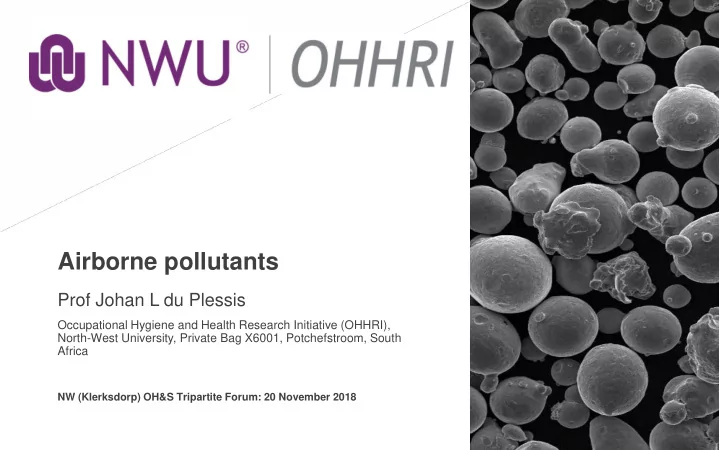

Airborne pollutants Prof Johan L du Plessis Occupational Hygiene and Health Research Initiative (OHHRI), North-West University, Private Bag X6001, Potchefstroom, South Africa NW (Klerksdorp) OH&S Tripartite Forum: 20 November 2018
Index • Background • Volatile organic compounds – Toluene • Manganese • Lead • Welding fumes • Diesel exhaust • Mixtures
Background • How are workers exposed? • What can be inhaled? • Particles – dust • Vapours – solvent • Fumes – metals • Fibers – asbestos
Background • Toxicology - ADME • Absorption – how does it get in? • Distribution – where will it go? • Metabolism – how will it be broken down? • Excretion – how does it leave? • Short-term (acute) vs Long-term (chronic) exposure • Health effects • Short-term vs Long-term
Volatile Organic Compounds: Toluene 1,2 • Flammable, colorless, volatile liquid • Exposure mainly through inhalation (skin possible) to vapour • Present in paint, thinners, glues, cleaning products, etc. • Non-occupational exposure possible • Smoking (conflicting) • Alcohol consumption • Benzoate consumption • Substance abuse (“glue sniffing”) • Co-exposure to other solvents
Volatile Organic Compounds: Toluene 1,2 • Central nervous system depressant • Long-term, low levels = sub-clinical change in blue-yellow vision • Spontaneous abortion in females • 100 ppm exposure = intoxication and reduced performance • Neurobehavioral, color vision, reproductive and developmental changes • Higher levels • CNS encephalopathy (brain damage) • Headache • Depression • Lassitude • Impaired coordination • Impaired reaction time
Manganese 3,4 • Accumulates in the body • Neurotoxic • Long-term low level exposure • Sub-clinical effects - decreased co-ordination and deterioration in motor function (muscle movement) • Long-term exposure • “ Manganism ” – resembles Parkinson’s disease • Not clear if sub-clinical effects are reversible • Cardiovascular effects – blood pressure and heart rate?
Lead 5 • Different types of lead: • Inorganic lead – pigments, paints, dyes • Organic lead – leaded petrol • Lead alloys – batteries, ammunition • Non-occupational exposure possible • Loading ammunition, lead-glass work, etc. • Accumulates in body
Lead 5 • Nervous system – peripheral neuropathy • Blood effects – low red blood cell count, decreased oxygen • Kidney – fibrosis, kidney failure • Hypertension • Bone effects – osteoporosis, substitutes calcium in bones • Digestive system – colic • Carcinogen (IARC) • Inorganic lead compounds – Probable human carcinogen (stomach)
Welding fumes 6,7 • Complex mixture of metal oxides, silicates and fluorides. • Fume – formed when metal is heated above boiling point and its vapours condense to form very small (solid) particles • Fume composition • Type of welding • Material welded • Coatings on material welded • Welding gases (shielding, fuel, process, coatings)
Welding fumes 6,7 • Metals • Aluminium, antimony, arsenic, beryllium, cadmium, chromium, cobalt, copper, iron, lead, manganese, molybdenum, nickel, silver, tin, titanium, vanadium, zinc • Short-term effects – eye, nose, throat irritation, dizziness and nausea, “metal fume fever” • Long-term exposure – cancer (lung, larynx, urinary tract)
Diesel exhaust 8,9 • DE = Mixture of gases and very small particles (DPM) • DPM = soot particles (carbon), ash, metallic abrasion particles, sulfates and silicates • Particles < 10 µm • Most < 1 µm • PAHs = carcinogenic
Diesel exhaust 8,9 • Short-term effects • Eye, nose and throat irritation • Headache • Dizziness • Long-term effects • Increased risk of cardiovascular, cardiopulmonary and respiratory disease (asthma, COPD) • Cancer (lung, bladder)
Diesel exhaust 8-10 • Exposure limits • OSHA (USA) • DPM = 160 µg/m 3 of total carbon (underground metal/non-metal mining) • Carbon monoxide = 50 ppm • Nitric oxide = 25 ppm • Nitrogen dioxide = 5 ppm (ceiling) • Is there a safe limit/threshold for exposure to a chemical carcinogen? • Not known • < 100 µg/m 3 of total carbon (< 75 µg/m 3 of elemental carbon)
Mixtures COP p.78-81 • Some mixed exposures involve substances that act on different body tissues or organs, or by different toxicological mechanisms, these various effects being independent of each other. • Compliance if exposure < OEL of individual substance • Other mixtures will include substances that act on the same organs, or by similar mechanisms, so that the effects reinforce each other and the substances are additive in their effect. (i.e. 2 + 3 = 5) • Compliance if exposure = C 1 /L 1 + C 2 /L 2 + C 3 /L 3 < 1 • In some cases the overall effect is considerably greater than the sum of the individual effects and the system is synergistic (i.e. 2 + 2 = 20) • Synergistic (Potentiation) > Additive > Individual
Contact information Prof Johan du Plessis Occupational Hygiene and Health Research Initiative North-West University Johan.duPlessis@nwu.ac.za
References 1. ACGIH (2010). Documentation on BEIs. Toluene. ACGIH. 2. Bruckner et al. (2013). Chapter 25 in Casarett & Doull’s Toxicology. 3. IMnI (2013). http://www.manganese.org/images/uploads/pdf/Manganese_Fact_Sheet_7.pdf 4. O’Neal and Zheng (2015). Curr Environ Health Rep, 2:315-328. 5. Tokar et al. (2013). Chapter 24 in in Casarett & Doull’s Toxicology. 6. OSHA Fact Sheet (2013). https://www.osha.gov/Publications/OSHA_FS-3647_Welding.html 7. CCOHS (2018). https://www.ccohs.ca/oshanswers/safety_haz/welding/fumes.html 8. OSHA Hazard Alert (2013). https://www.osha.gov/dts/hazardalerts/diesel_exhaust_hazard_alert.html 9. Taxell and Santonen (2017). Toxicol Sciences, 158:243-251. 10. Mohankumar and Senthilkumar (2017) Renew Sustain Energy Rev, 80:1227-1238.
Recommend
More recommend